There are TVs that come for testing, and you immediately think: "oh, just another average one, probably like many others." And essentially... that's true. The TCL C7K doesn't try to dethrone OLEDs, nor does it scream "revolution!" from the box. And yet, after a few days of testing, it's hard not to think: "wow, this is really good gear." And that's exactly what the C7K is. The biggest advantage of the C7K is the decent picture at a reasonable price – MiniLED and quantum dots do their job here. The colours are vibrant, the brightness is satisfactory, the contrast impresses, and with the right settings, you can truly enjoy viewing in the best quality. The second strong point is motion smoothness – both in sports and gaming. Support for HDMI 2.1, variable refresh rate, 144 Hz, and a whole heap of other features makes gaming on this TV a pure pleasure. On top of that, there's Google TV, which – despite some minor shortcomings – offers access to almost an endless library of apps. Voice control, quick access to YouTube, Netflix, AirPlay support – it has everything you need for daily use. Are there downsides? Of course. The Google TV system can have moments of "hesitation," and MiniLED – like any MiniLED – can stumble on very challenging movie scenes. But these are details. After all, the C7K is a mid-range model – and in this class, it performs remarkably well. So if you’re looking for a reasonably priced, modern TV with Google TV that looks good, works well, and sounds pretty decent without breaking the bank – the TCL C7K definitely deserves your attention.
- Matching (Score)
- Our verdict
- TV appearance
- Where to buy
- Contrast and black detail
- HDR effect quality
- Factory color reproduction
- Color reproduction after calibration
- Smoothness of tonal transitions
- Image scaling and smoothness of tonal transitions
- Blur and motion smoothness
- Console compatibility and gaming features
- Input lag
- Compatibility with PC
- Viewing angles
- TV efficiency during daytime
- Details about the matrix
- TV features
- Apps
- Playing files from USB
- Sound
TCL C7K / QM7K vs Philips OLED820
Direct compare
C7K / Q7C / MQLED85K / C79K / C71K / QM7K
Available screen sizes: 50”
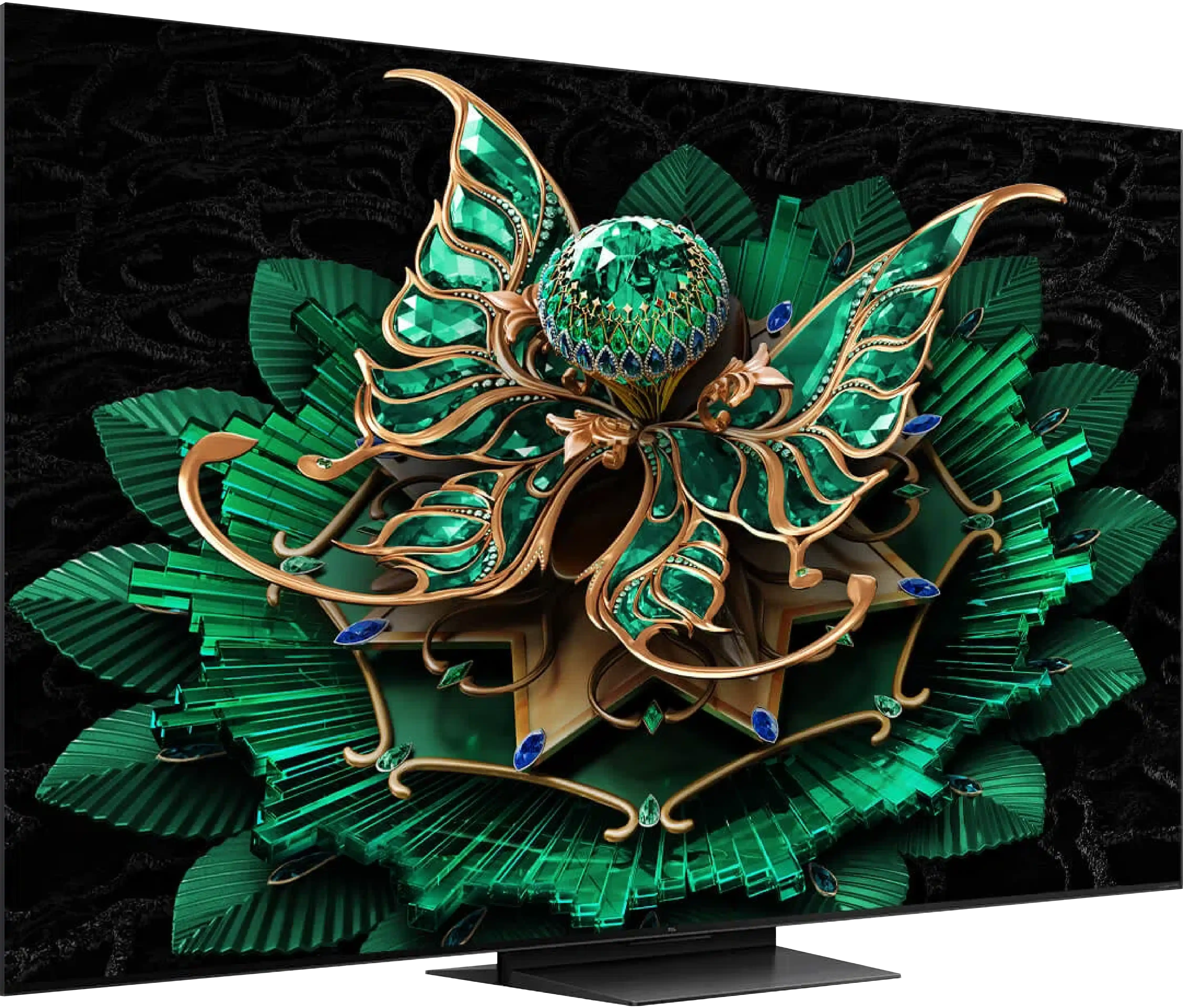

Panel type: LCD VA
Resolution: 3840x2160
System: Google TV
Model year: 2025
Complete the survey to find out the result

Panel type: WRGB OLED
Resolution: 3810x2160
System: Google TV
Model year: 2025
Complete the survey to find out the result

Overall rating
7.2
8.0
Movies and series in UHD quality
6.7
8.3
Classic TV, YouTube
6.5
8.6
Sports broadcasts (TV and apps)
6.6
8.5
Gaming on console
8.5
9.4
TV as a computer monitor
8.4
6.5
Watching in bright light
6.1
5.7
Utility functions
7.3
6.8
Apps
9.6
9.6
Sound quality
7.0
7.7
Complete the survey to find out what fits your preferences
Advantages
Very good black - VA panel with a large number of Mini-LED zones
High brightness in HDR - over 1000 nits
Great for gamers - HDMI 2.1, low input lag, VRR, ALLM etc.
Good motion fluidity - 144Hz panel
Support for multiple HDR formats: HDR10, HDR10+, Dolby Vision
Google TV operating system with access to a huge app base
Pleasant sound from built-in speakers
Perfect contrast and black level thanks to the WOLED panel
High HDR brightness (up to 1300 nits) and wide coverage of the DCI-P3 colour space (99%)
Support for multiple HDR formats including Dolby Vision and HDR10+
Excellent motion smoothness, no blur, refresh rate up to 144 Hz
Full support for gamers: HDMI 2.1 (2 ports), VRR, ALLM, HGiG, Dolby Vision in games, low input lag
Ambilight, which significantly enhances the viewing experience and sets the TV apart from the competition
Google TV system with a massive app base and an excellent voice assistant
Extras including: Backlit remote and swivel stand
Support for audio formats Dolby Atmos and DTS:X
Disadvantages
Google TV can have minor stutters
No USB recording and PiP function
Only two HDMI 2.1 ports (with 2 consoles and a soundbar, we are forced to "juggle" the cables)
Lack of many classic "TV" features such as USB recording or PiP mode, infrared remote may be annoying
Slight issues with colour matching (much better than last year but still far from the competition)
Issues with font readability when working with PC (lack of full Chroma 4:4:4 support)
Our verdict
The Philips OLED820 is a very successful and significant step forward compared to last year's model, the OLED 819. For many people, the main reason for purchasing will, of course, be Ambilight: a multicoloured backlighting system that distinguishes Philips televisions from the competition. It's no surprise, as it made a huge impression on us as well. It’s not just an impressive gadget, but a real addition that can change the perception of the content being watched and add depth to it. However, Ambilight should not overshadow what the OLED820 offers as a screen. We have almost infinite contrast, high brightness in HDR films, and excellent colour reproduction, which becomes even better after a slight adjustment or professional calibration. This set guarantees one of the best images available on the market today, and we are also aware that the television offers something unique and unprecedented anywhere else. It is also equipment that will perform well in gaming. The 144 Hz panel and HDMI 2.1 ports provide access to the full capabilities of next-generation consoles, and the low input lag makes gameplay exceptionally responsive. The operating system – Google TV – also deserves praise. It’s a much better solution than the proprietary Titan OS found in lower Philips models, such as the OLED770. This is a significant argument for paying extra for this model. A larger library of applications, a more efficient voice assistant, and fewer system errors translate to a clearly better everyday experience. Of course, the Philips OLED 820 is not free from minor shortcomings – there are some software gaps, and some features could be better refined. Nevertheless, the overall presentation is very solid. Perhaps the OLED820 is not a revolutionary television, but it is a very successful and well-balanced offering in Philips' lineup. It combines excellent picture quality, a full set of features for gamers, and a unique addition in the form of Ambilight. If you are looking for a solid mid-range OLED that gives not only a good picture but also something distinctive and exceptional, the OLED820 should be high on your shopping list.
TV appearance
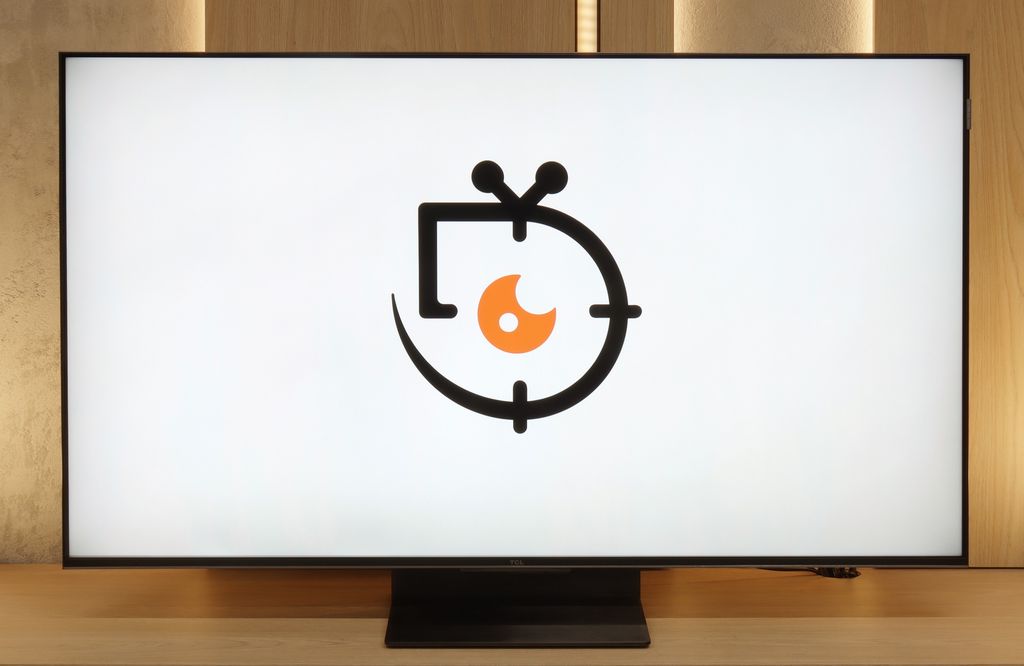
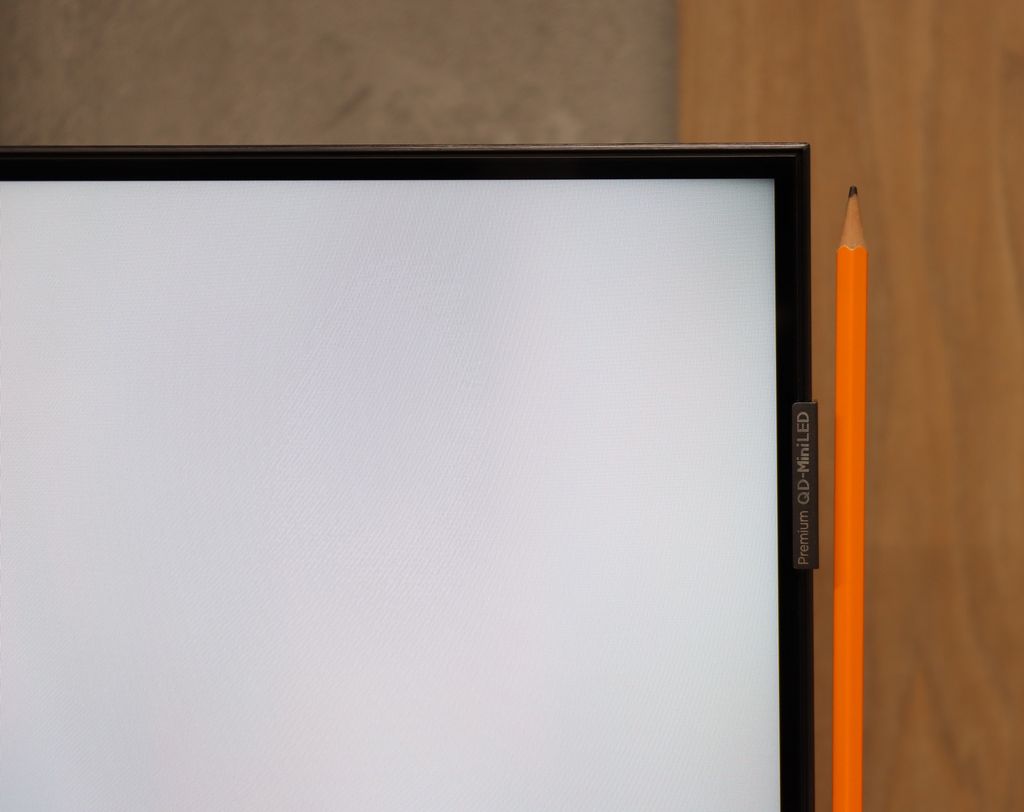
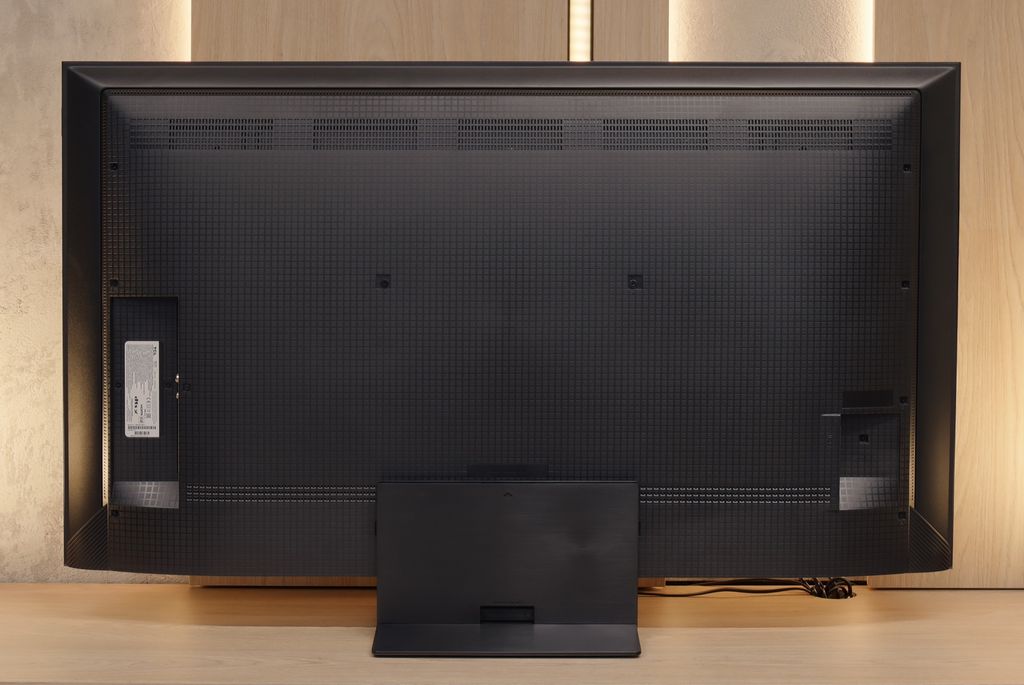
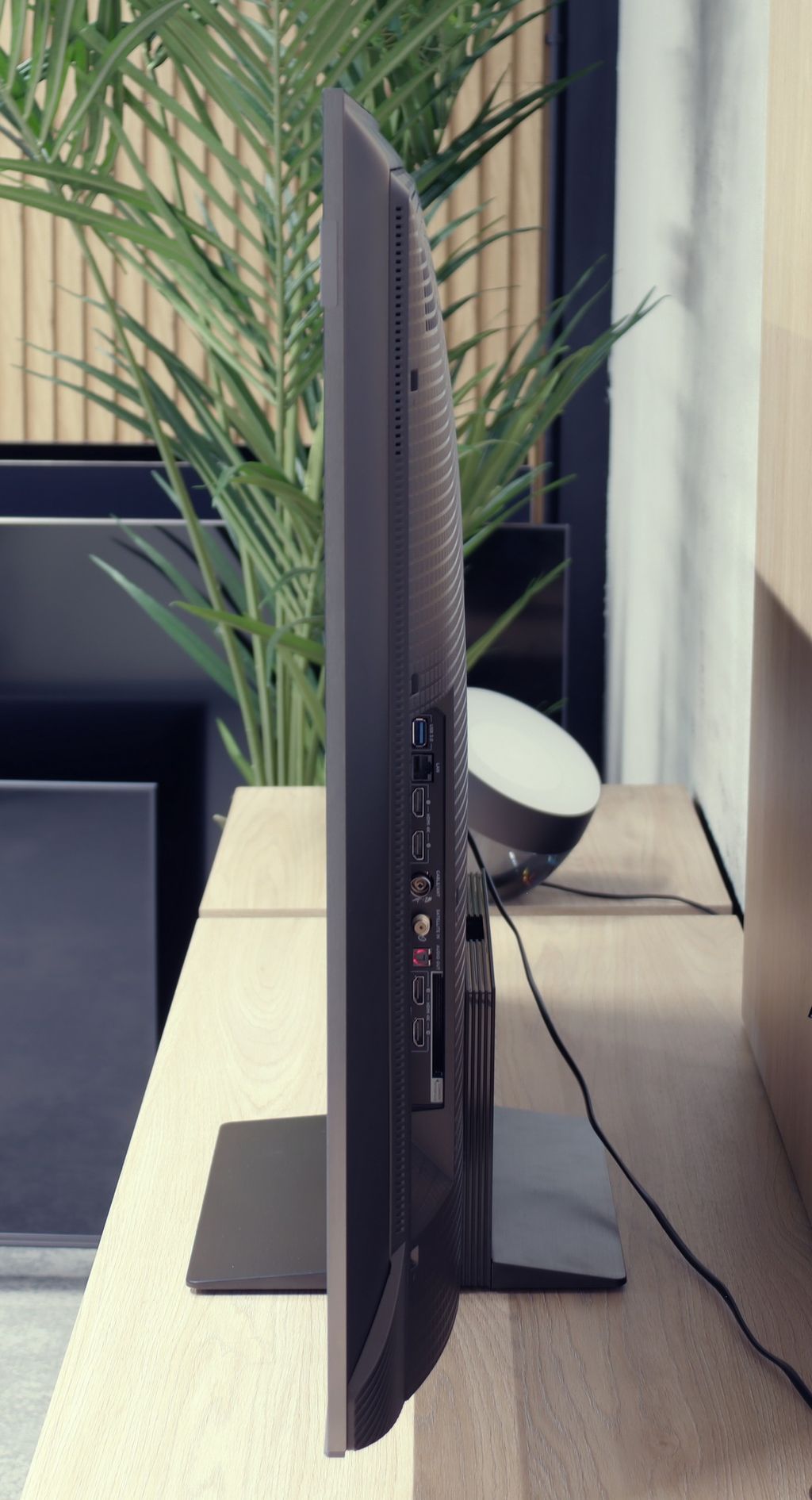




Contrast and black detail
7.1/10
10/10
Local dimming function: Yes, number of zones: 336 (14 x 24)
Contrast:

Result
161,000:1

Result
18,750:1

Result
13,150:1

Result
6,300:1

Result
4,200:1

Result
∞:1

Result
∞:1

Result
∞:1

Result
∞:1

Result
∞:1
Halo effect and black detail visibility:
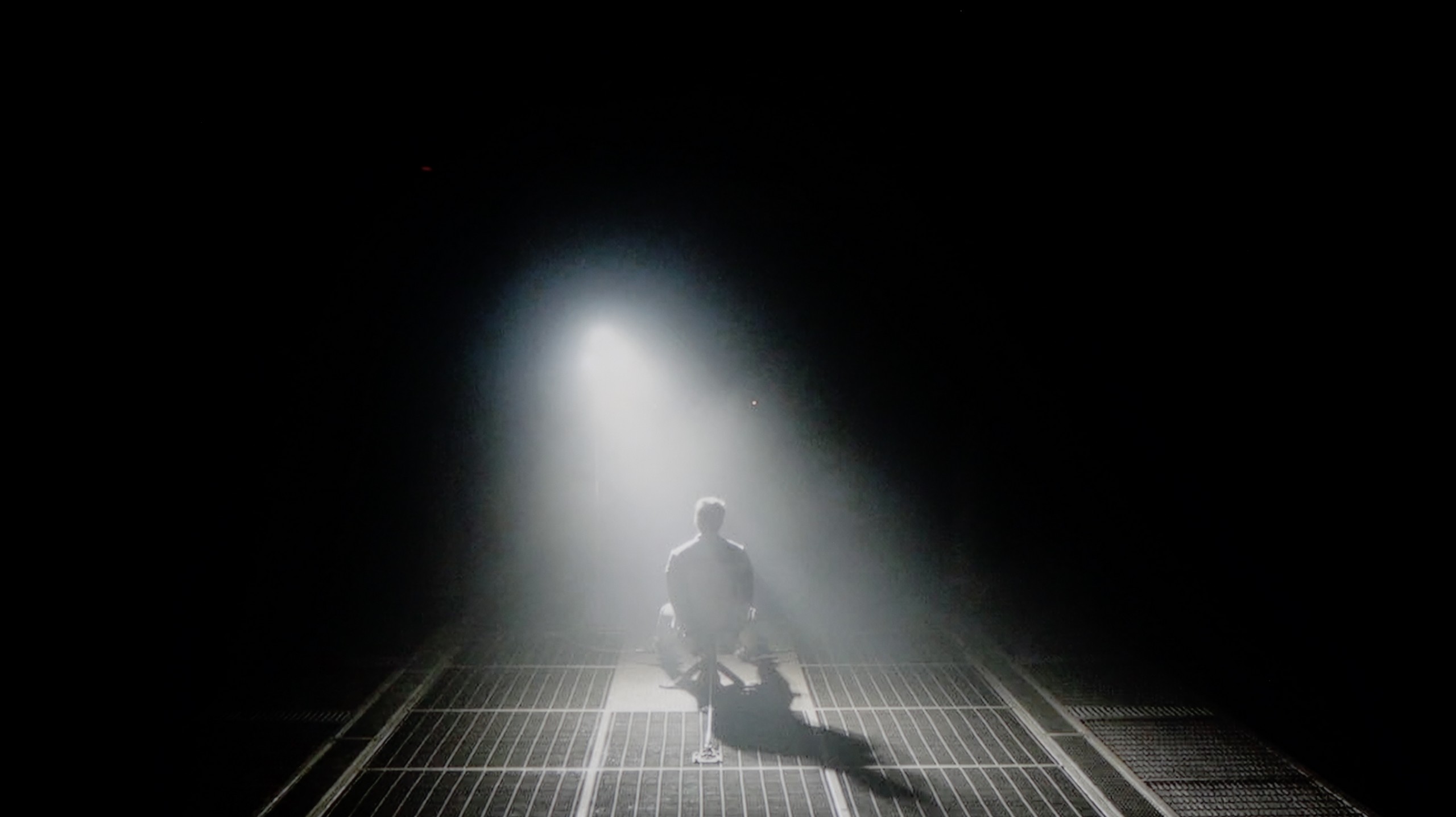

The 50-inch TCL C7K we tested surprised us right from the start – it's the smallest model in the series, yet it's equipped with a VA panel with MiniLED backlighting and – get this – as many as 336 dimming zones. By comparison, many far larger TVs from higher tiers would be happy to boast such a number. Here we have it in a 50-inch version. Sounds promising, right? So how does this translate into real viewing experiences? In the overwhelming majority of tested scenes – very well. The contrast was high enough that in measurements it reached even six-figure values, which in practice means very deep blacks and well-separated highlights. In scenes from films like The Revenant or Oblivion, the effect was impressive, matching the best LCD screens in this class.
Not everything, however, went perfectly. Despite the impressive number of zones, managing them wasn't always exemplary. In more complex scenes, where small light sources or a high level of detail appear, the TV had issues with the so-called halo effect (a glowing aura around bright objects) or overly aggressive dimming of the image. In such situations, contrast could either collapse due to overexposure of some zones or, conversely – details in bright areas vanished because the zones were suppressing light too much. Nevertheless, it's worth emphasising that in the vast majority of scenes the contrast was more than satisfactory. And considering the size of the TV and the price, the final effect will satisfy not only average users.
Contrast and black are the domain of OLEDs, and the Philips OLED820 is no exception. The WOLED panel from LG Display works exactly like the models LG C5 or Samsung S90F and delivers precisely what we expect – perfect black and infinite contrast. Whether we're watching challenging scenes full of fine details or simpler shots drenched in uniform black, the television always performs superbly. It separates light from dark with surgical precision, creating an extraordinary sense of depth in the image. And while there can be discussions about different technologies, in this category OLED simply rules, and the Philips OLED820 only confirms this rule.
HDR effect quality
5.4/10
7.5/10
Luminance measurements in HDR:

Result
1051 nit

Result
185 nit

Result
454 nit

Result
200 nit

Result
836 nit

Result
1035 nit

Result
1235 nit

Result
1356 nit

Result
1315 nit

Result
521 nit
Scene from the movie “Pan” (about 2800 nits)


Scene from the movie “Billy Lynn” (about 1100 nits)


Static HDR10


Dynamic: Dolby Vision
Dynamic: Dolby Vision


HDR luminance chart:
Philips OLED820
HDR luminance
Luminance of RGB colors
TCL C7K / QM7K
HDR luminance
TCL C7K is one of the brightest MiniLED TVs in its price class. Under optimal testing conditions, the screen can achieve over 1200 nits, resulting in impressive, at times dazzlingly bright scenes. And most importantly – this isn’t just a theory from measurements. In practice, even the brightest moments in movies can shine with true cinematic grandeur. Home HDR cinema fans should be really pleased.
The impression is fantastic, especially in scenes with large areas of brightness – a white sky, explosions, sun reflections, or magical sunsets can surprise with an intensity of light that rarely appears in this price range.
However, things get a bit worse when more challenging scenarios appear on the screen, previously described in terms of contrast – that is, images full of details, with small bright elements on a dark background. In such cases, the C7K often opts to preserve black at the expense of brightness. An example? Scenes from movies like Sicario 2 or Life of Pi, where small light sources (like a distant lantern) may become less visible, and details in the lights are simply dimmed or blend into the background.
For many viewers, this may be an acceptable compromise – as we achieve deep blacks and pleasant image depth. Nevertheless, it’s important to recognise that the visibility of small details in bright areas is not this model's strong suit. It’s simply a technological limitation that still exists – even with over 300 zones.
When it comes to HDR quality, the Philips OLED820 uses the same class of WOLED panel found in its biggest rivals – the LG C5 and the Samsung S90F. This means we can expect really solid results. This year, mid-range OLED panels can exceed the threshold of a thousand nits, and the tested model reaches around 1300 nits in some films. This is an outstanding result, allowing the director's vision to be conveyed with incredible precision, as this is the brightness range in which modern productions are mastered. Of course, there are situations where even the OLED820 has to compromise. Full-screen scenes flooded with white, like those in the film The Meg, can drop brightness to 400–500 nits, which clearly diminishes the effect. This is a characteristic of OLED technology that has not yet been fully eliminated. Despite this limitation, it's hard not to appreciate the HDR in this model – high luminance and a wide coverage of the DCI-P3 colour palette at 99% make the image look simply fantastic.
Factory color reproduction
6/10
6.7/10
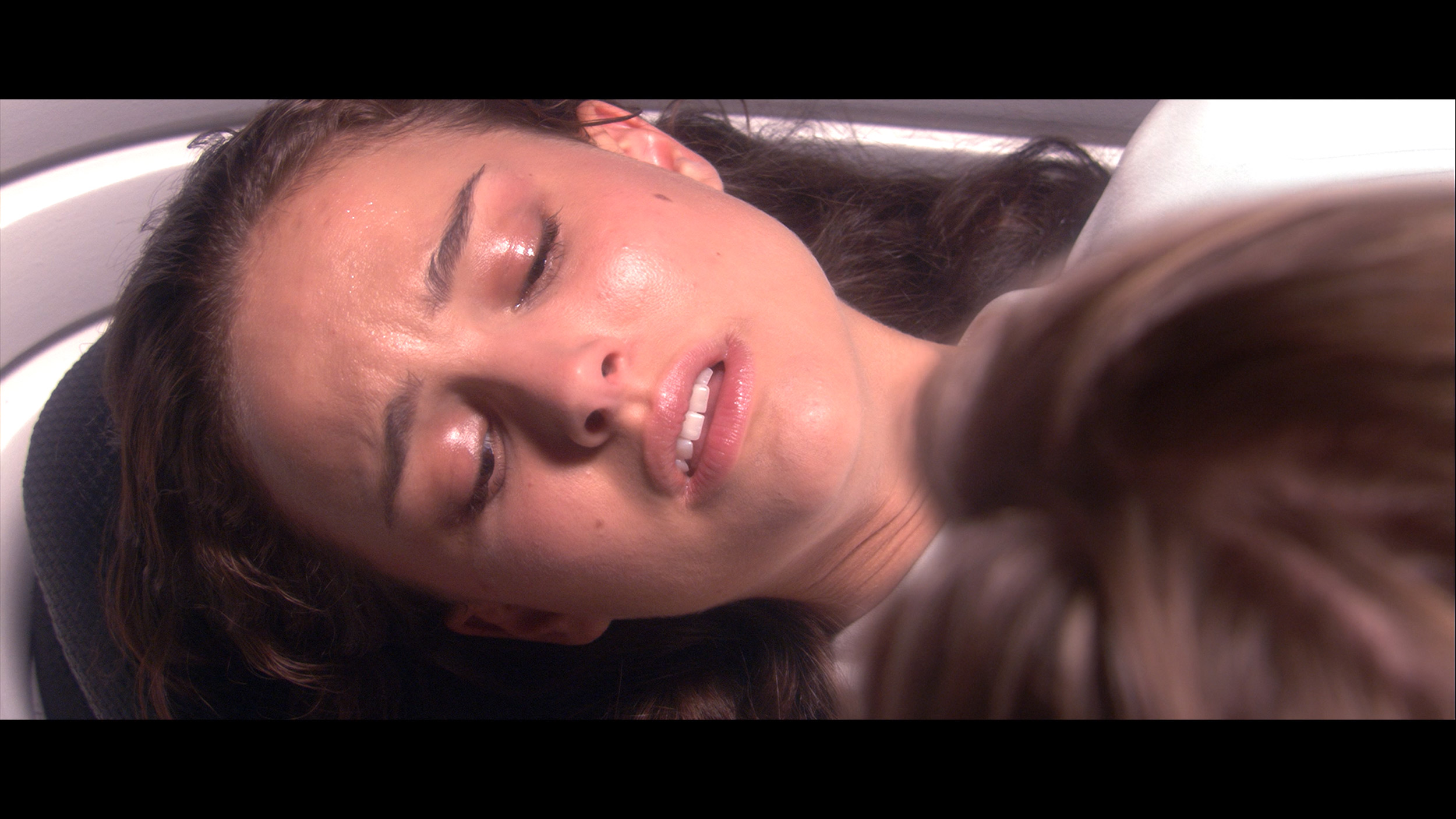
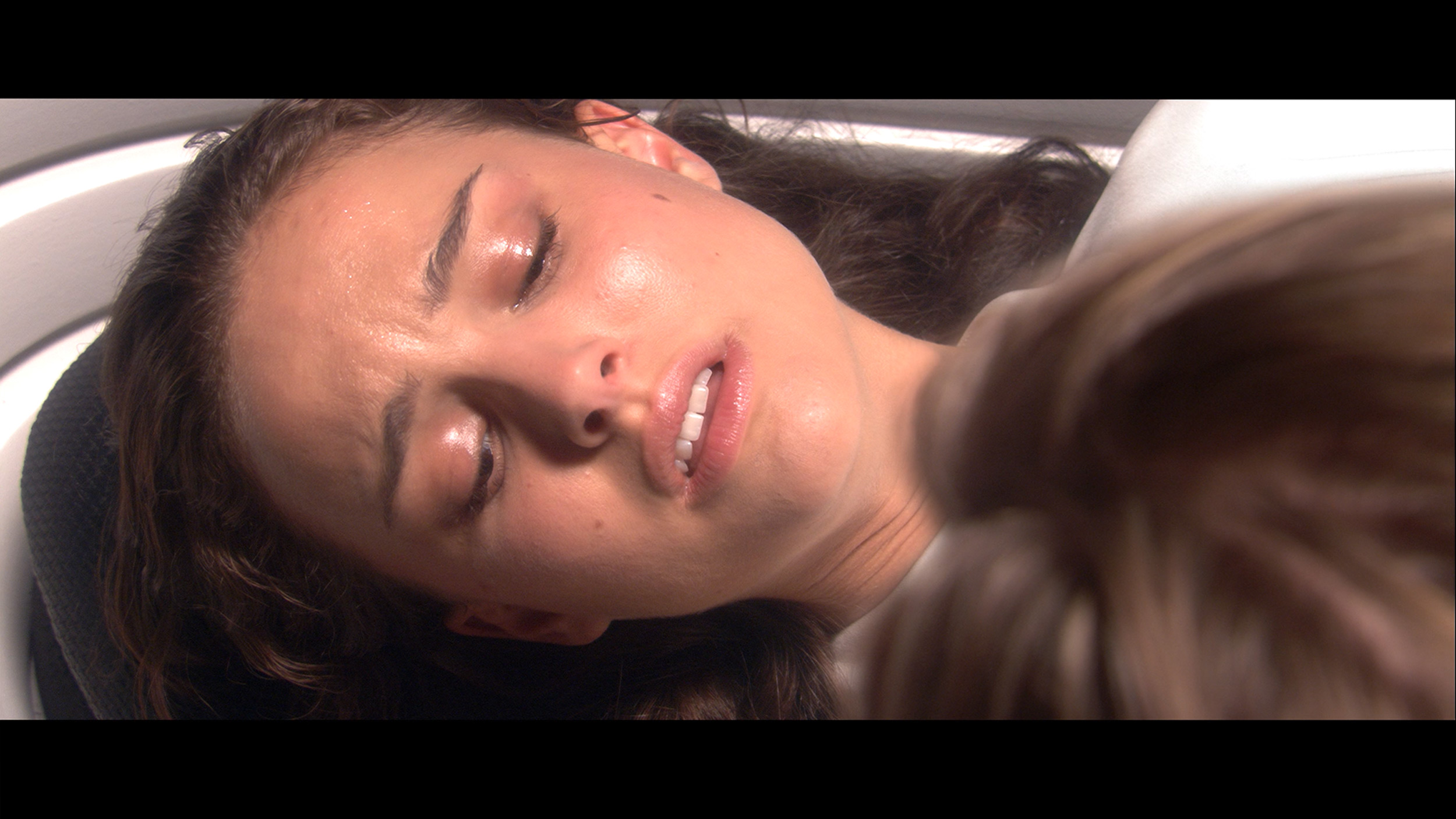
Factory Mode
After calibration


Factory Mode
After calibration
A new feature in TCL televisions for 2025 is the long-awaited Filmmaker mode, which until now has been found in most competing brands. This is great news, as this mode is considered the most faithful to the original vision of the creators and is often recommended by enthusiasts of quality visuals. Unfortunately – as is often the case – the mere presence of it does not guarantee perfection. The Filmmaker mode in the TCL C7K is not without its faults. There are issues with inaccurate white balance, particularly a slight blue tint that resulted in cool, somewhat greyish skin tones. But that wasn’t the biggest problem. The main complaint was excessive brightness exposure, which is clearly visible on gamma and EOTF charts. The image was simply too bright, at times even blown out, which affected not only the texture of scenes but also the overall viewing experience. Some details were just lost, and the entire image looked as if someone had overdone the brightness slider. As always, we decided to see what could be squeezed out of it after calibration. And this is where things started to get really interesting…
The colour reproduction in the factory settings really surprised us, and in a positive way. The Philips OLED820, switched to Filmmaker mode, immediately showed that it was quite well tuned in terms of colour. The white balance was relatively accurate, although there was a slight deficiency in the blue hue, which sometimes gave the image a slightly yellowish tint. However, this is not a drawback that particularly interferes with everyday viewing. A bigger problem arose with the brightness characteristics. The gamma chart clearly deviated from the ideal, as the line was below the expected values, causing the image to be excessively brightened, and the colours looked as if they were covered with a light milky filter. This effect was also noticeable in tests using the Colour Checker pattern, where more pronounced errors appeared.
Color reproduction after calibration
7.5/10
9.3/10




After calibration, the TCL C7K showed itself in a really good light, especially when it comes to SDR content. We managed to precisely tune the white balance, colour gamut, and brightness characteristics so that the colour errors on the ColorChecker palette fell below a value of 2. For the uninitiated – this is nearly a perfect result, which means that the image is very close to what the creators intended. Unfortunately, it was a different story with 4K HDR content. While we were able to slightly calm down the white balance and correct its earlier errors, it was still evident that the TV has some "MiniLED traits", particularly in brightness management. When we checked how the C7K handled the EOTF curve on real film scenes, rather than just on synthetic test patterns, it turned out that the screen still had a tendency to slightly brighten the entire image. This affects the overall experience – the black loses some depth, and the image becomes less contrasty than it should be. Despite these minor issues with HDR content, the overall reception of materials – especially in SDR – is really very good. After calibration, the C7K can display an image that can successfully compete with much more expensive models. Good colour tuning, natural skin tones, and pleasant brightness make movie watching and everyday content viewing more than satisfactory.
After calibration, both the Filmmaker mode and the gaming mode improved quite a bit. A slight adjustment of the white balance and enhancement of the brightness characteristics yielded excellent results with SDR content – the image looked nearly perfect, natural, and very close to the reference. For HDR material, the situation was similar; the colours looked fantastic, and it was hard to find fault with anything. However, we did notice a certain characteristic, which we had already pointed out when comparing scenes from the film Billy Lynn. The analysis of the EOTF curve showed that the TV has a slight tendency to dim details in the blacks, meaning that the darkest parts are not always displayed exactly as the director intended. Nevertheless, the effect after calibration is superb, and the OLED820 is emerging as one of the more interesting screens in its class. A little bit of fine-tuning is all that’s needed, and there’s really nothing to worry about.
Smoothness of tonal transitions
8.6/10
6.5/10












The TCL C7K performs very well with colour gradation – in most of the scenes tested, tonal transitions were smooth, and colours blended together without visible outlines or the artificial effect of "blotches". In everyday use, it's hard to find any faults – the picture looks natural, without jarring transitions or digital artifacts. Certain limitations only appear in very dark tones – especially in a heavily muted grey palette, where the television may struggle to reproduce the ideal gradation. But that’s absolutely understandable, as even many significantly more expensive models in this range simply can't cope. Fortunately, these situations are rare and don’t really affect the overall perception.
The fluidity of tonal transitions is unfortunately the Achilles' heel of the Philips OLED820. During testing, we noticed slight issues with colour blending – both in bright and darker scenes, there is a noticeable banding that detracts from the naturalness of the image. It must be said that compared to last year's model, the OLED 819, there is a significant improvement, but nonetheless, the competition performs better in this category.
Image scaling and smoothness of tonal transitions
5.5/10
7/10
Smooth transition function
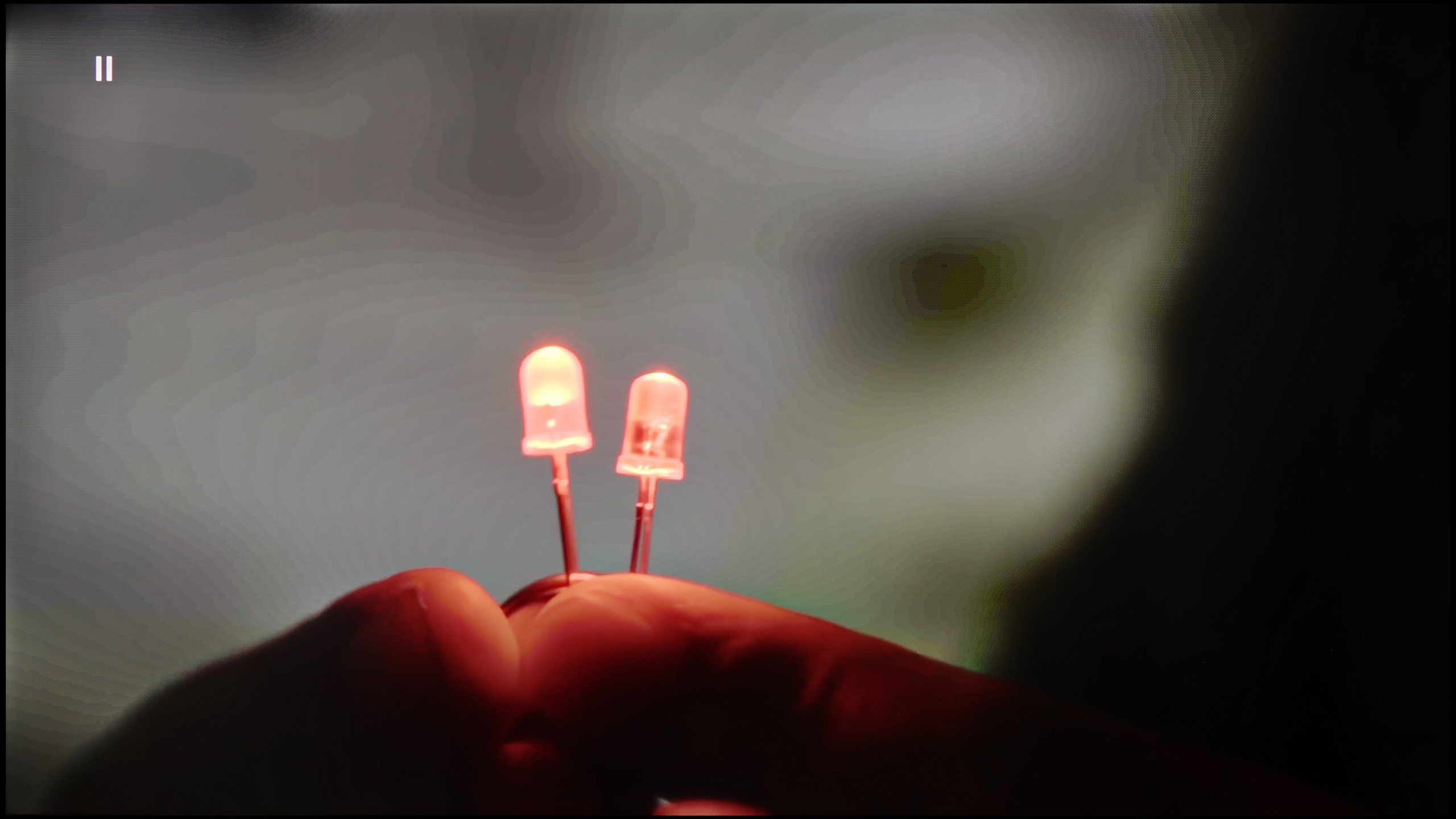

Image without overscan on the SD signal


TCL C7K has a feature that, according to the manufacturer, is meant to smooth out undesirable colour transitions – something like a rescue for less successful tonal shifts. It's called "Gradual Smoothing," and... well, it sounds ambitious, but in practice, it works very poorly. Regardless of whether we set it to low or high, the difference is minimal. Worse still – the feature can cut out elements from the image that should remain. Fortunately, film grain remains untouched, so at least it doesn't smooth everything indiscriminately, but even so – it's better to simply turn this option off.
When it comes to upscaling lower resolution content, it's already better. SD and HD materials look quite decent, although at times we had the impression that the image loses sharpness and becomes too soft – as if something took away its clarity. Fortunately, with very low sources (e.g., 576p), there was no overscan effect, meaning the image wasn't artificially cropped – everything fit on the screen as it should.
Fortunately, the earlier effects of the mentioned posterisation can be quite effectively mitigated. The "distortion reduction" feature set to medium handles unwanted colour banding well, improving the smoothness of tonal transitions. It does sometimes work a bit too aggressively and smooths out some details – such as the minor imperfections of the actors’ skin – but despite that, it can be considered worth using without major compromises. The upscaling in the OLED820 also performs well. The test image with the model is exceptionally soft, sometimes perhaps too much, although this can be remedied with a slight increase in sharpness in the picture menu – that's a matter of individual preference. The absence of overscan issues with very low-resolution content is also commendable, allowing us to not worry about the image being unnecessarily cropped.
Blur and motion smoothness
8.1/10
8.5/10
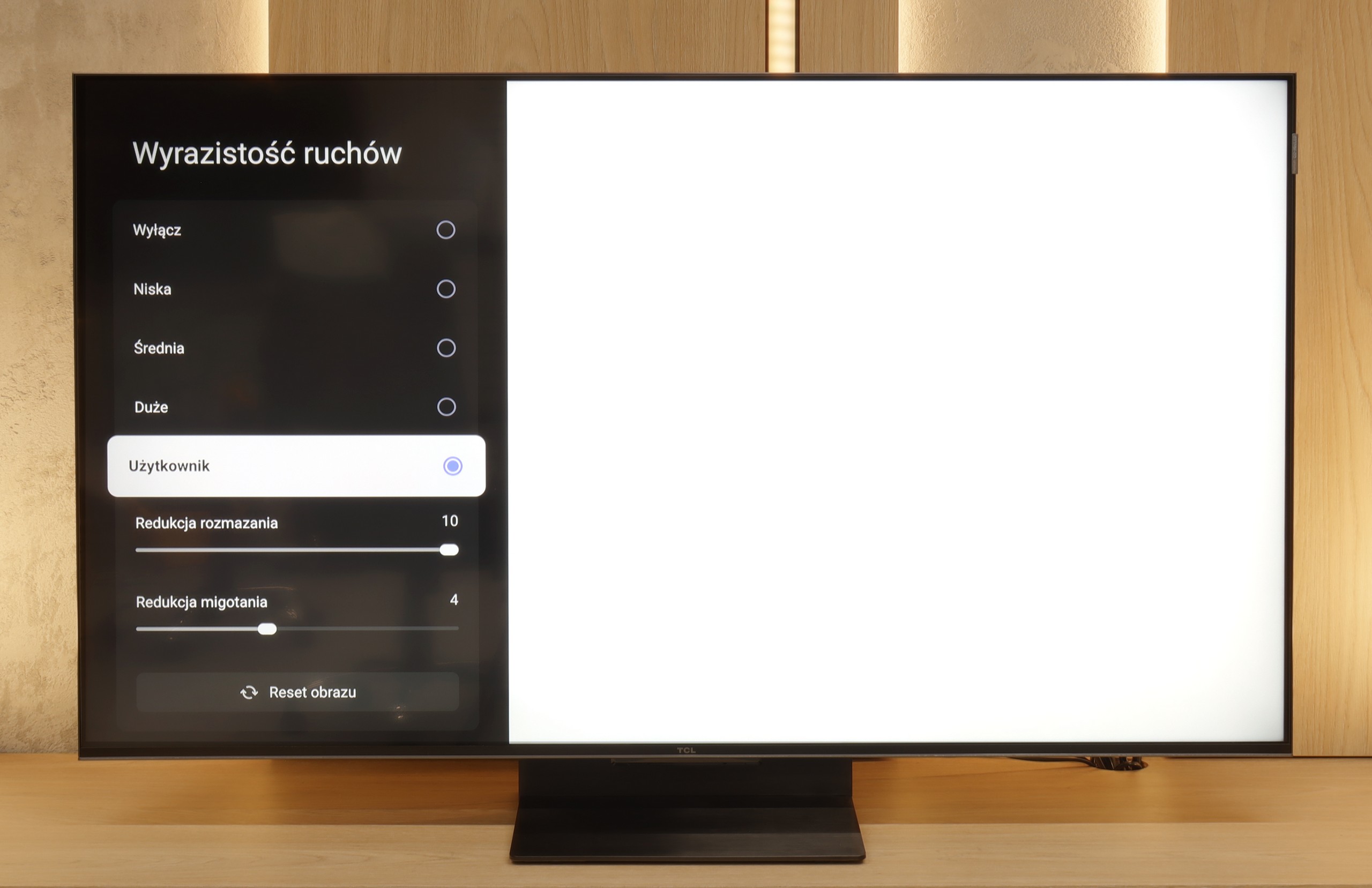

Blur (native resolution, maximum refresh rate):


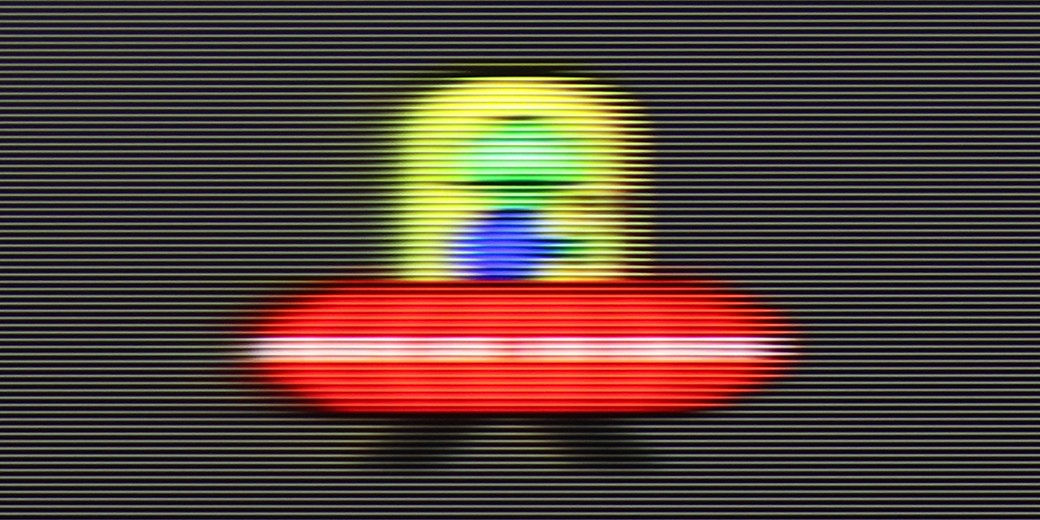



Blur (BFI function enabled):



Smużenie (4K 144Hz):



Smużenie (4K@144Hz):



TCL C7K handles motion fluidity really well. The panel it uses offers a refresh rate of 144 Hz, which suggests that this TV is more than just a standard "60 Hz" panel. Furthermore, if we connect the C7K to a computer and set the resolution to Full HD. But we will write more about this in the paragraph on gamers and PC compatibility. Returning to everyday use – both sports and movies look very good here. Thanks to the fast panel and the well-functioning motion smoother, the C7K is great for watching matches, but also for movie screenings. In the menu, we find two sliders – motion blur reduction and flicker reduction – that allow you to adjust the fluidity effect to your own preferences. At lower settings, we get a more cinematic effect, with slight judder. At higher settings – the image becomes more theatrical, fluid to the point of excess. Whatever your preference – everyone can set it their own way.
Motion fluidity is an area where OLEDs always shine, and the Philips OLED820 confirms this rule. The panel itself offers a refresh rate of 144 Hz, which will mainly benefit PC gamers, but even with standard TV sources or consoles, where it operates at 120 Hz, motion is fast, sharp, and simultaneously smooth, without any signs of smearing. This is thanks to the remarkable response time between pixels, which ensures the image maintains clarity in every dynamic scene. The manufacturer has also added their own smoothness enhancer called "Motion Style." In the menu, we find two sliders – the first, responsible for smoothness, allows for the adjustment of the number of artificially added frames in films. This way, we can choose a raw, cinematic character with clearly visible film frames or a more theatrical image with smooth motion. The second slider is for motion blur reduction, particularly useful in sports broadcasts. Here, we definitely recommend setting it to the maximum value, as the effect is truly excellent.
Console compatibility and gaming features
9.8/10
9.8/10
- ALLM
- VRR
- VRR range48 - 144Hz48 - 144Hz
- Dolby Vision Game Mode
- Correct implementation of HGIG
- 1080p@120Hz
- 1440p@120Hz
- 4K@120Hz
- Game bar
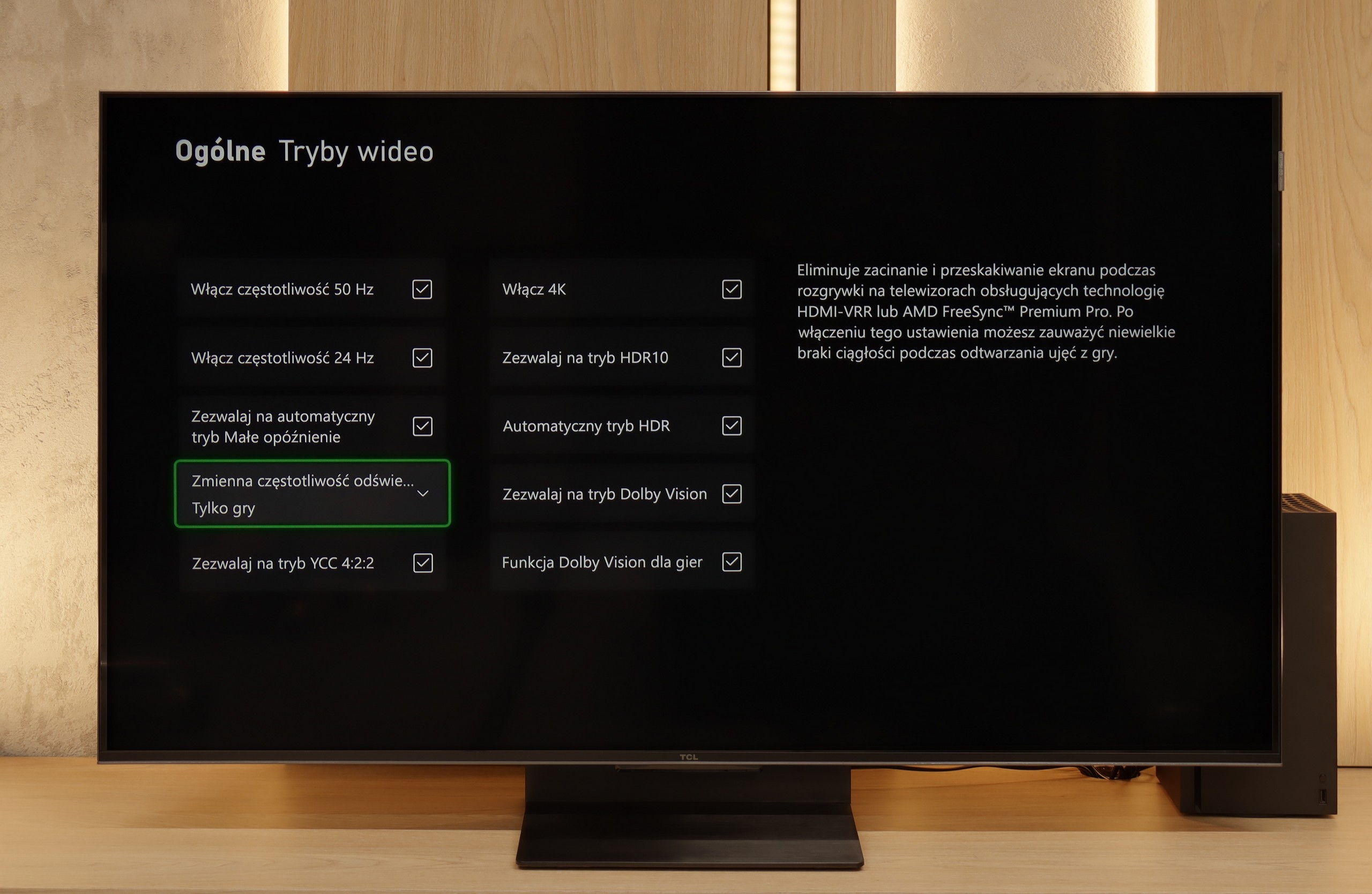

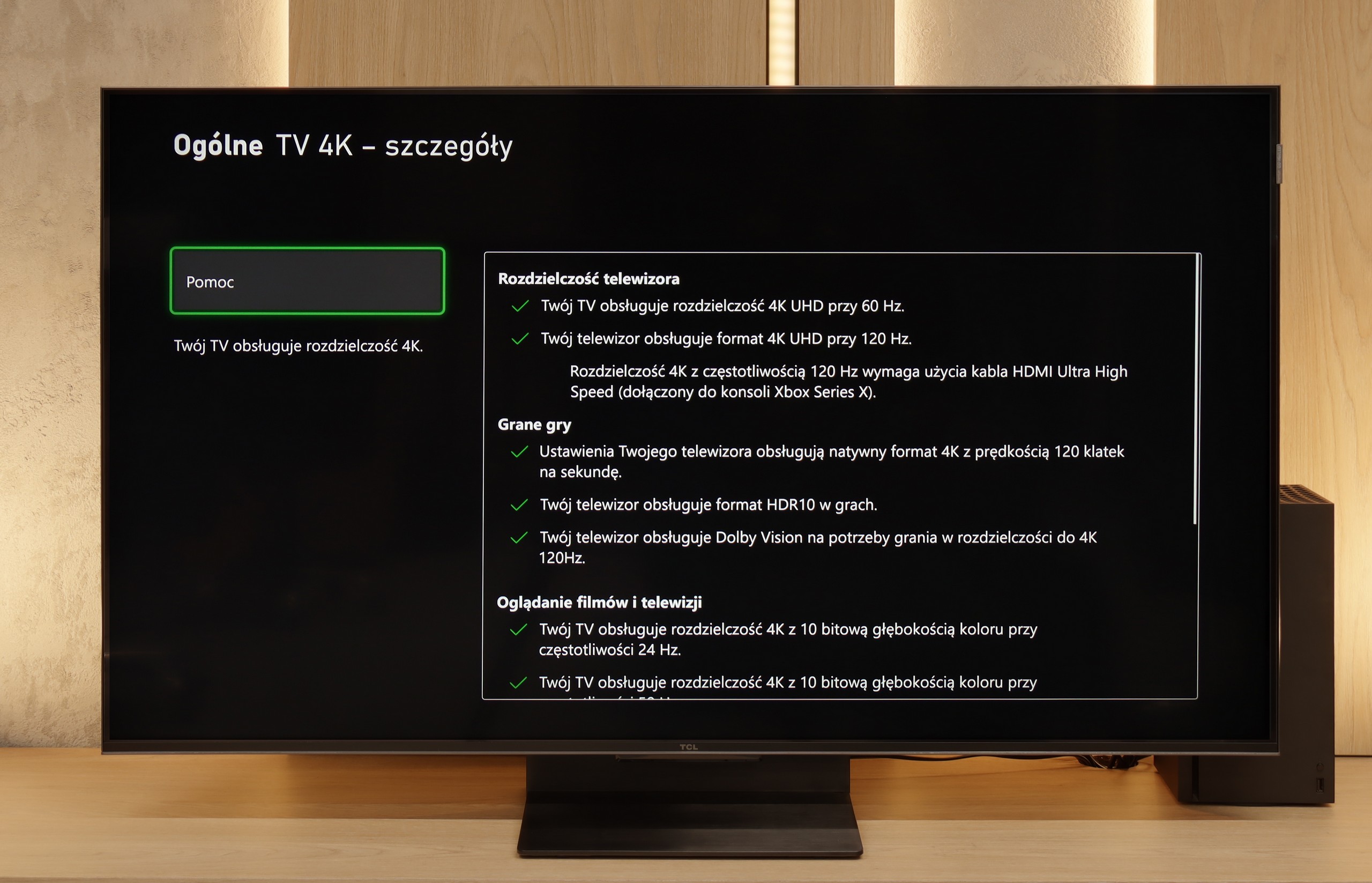

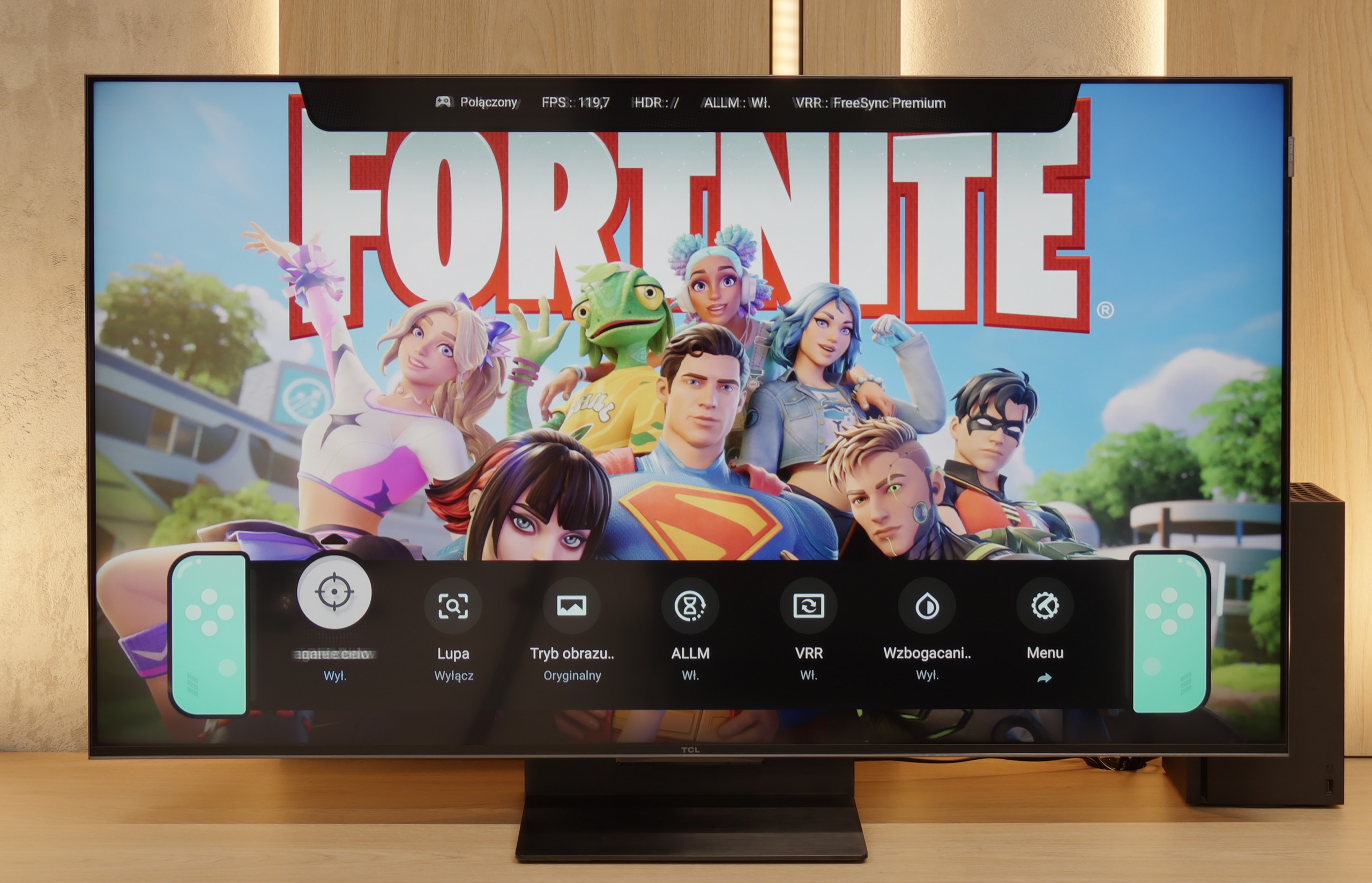

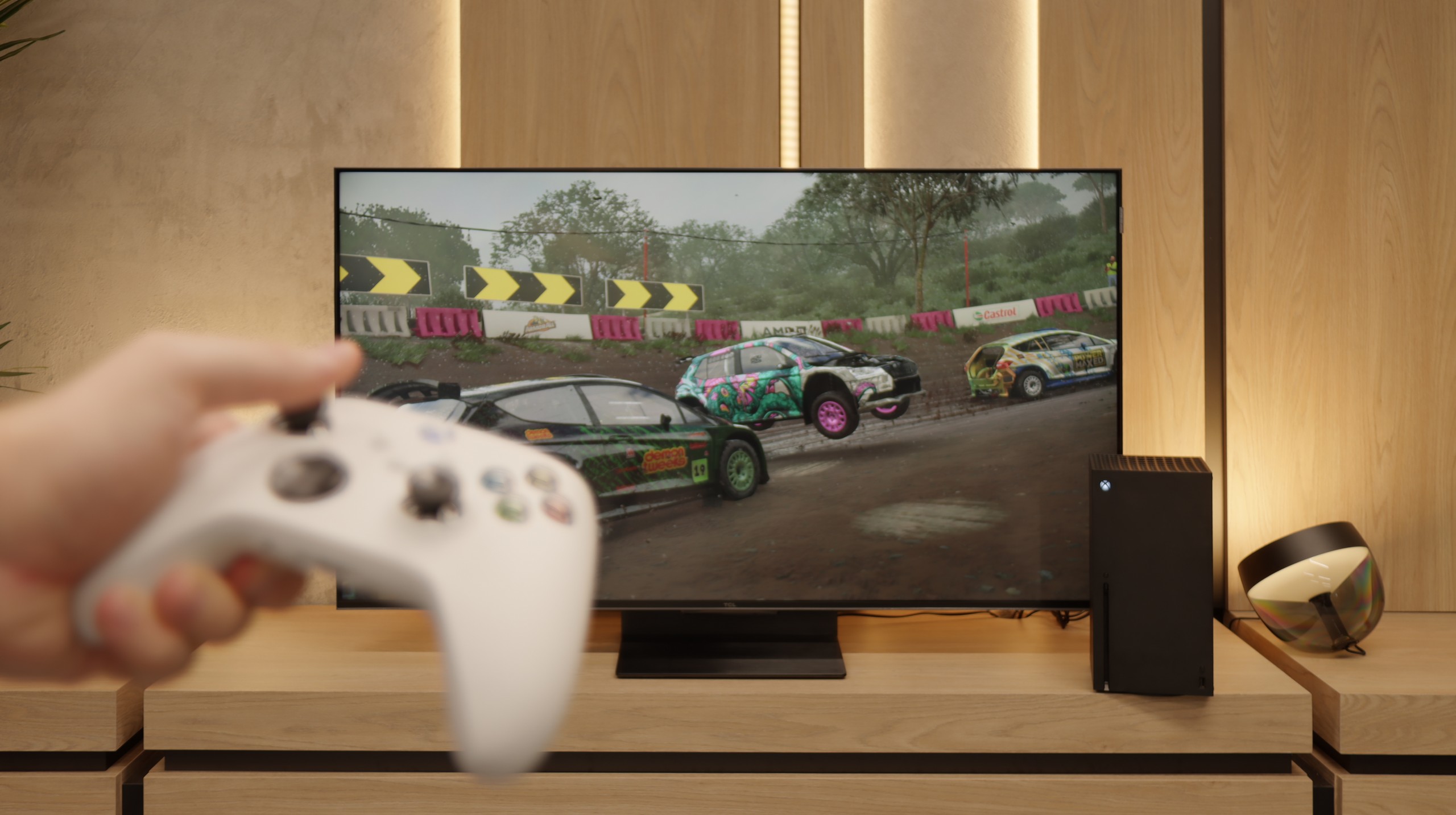

TCL C7K is a television that on paper looks like the perfect equipment for gamers – and most importantly, it performs well in practice too. Here's some good news: we have two full-bandwidth HDMI 2.1 ports, so we can easily connect both a console and a computer, using all their capabilities. The panel itself supports a refresh rate of 144 Hz, which provides a significant advantage in dynamic games. Additionally, it comes with a full set of gaming features: VRR (variable refresh rate), ALLM (automatic low latency mode), and support for Dolby Vision in games. There's also an HGiG mode that allows for HDR effects that align with the creators' intentions. GameBar, which is an information bar for gamers. It operates quickly, looks clear (like a Nintendo console👌), and shows what's most important: the current frame rate, VRR status, and even HDR parameters.
The Philips OLED820 is one of the most comprehensive TVs for gamers. Onboard, we find practically everything one could expect: two HDMI 2.1 ports with full bandwidth of 48 Gbps (shame there aren't four), Variable Refresh Rate (VRR), Auto Low Latency Mode (ALLM), support for Dolby Vision in games, and a good implementation of the HGiG mode. The TV also handles lower resolutions at 120 Hz without issue, so you can count on great flexibility when choosing different picture modes on your console. Philips also adds a Game Bar – a panel that allows you to change picture modes, add a crosshair, or preview parameters. Although it looks a bit clunky and is less refined than its competitors, it gets the job done. In practice, therefore, the OLED820, in addition to a full set of four HDMI 2.1 connections, offers almost everything a gamer could need.
Input lag
9.7/10
10/10
SDR
HDR
Dolby Vision
When it comes to delays, the C7K gives no reasons to complain. In games at 120 Hz, the input lag is around 10 ms, which means that the TV responds really quickly. Interestingly, even in Dolby Vision mode, the result is very similar, which isn't always the case. Good job, TCL. At 60 Hz, the lag does increase a bit, but that's completely normal and applies to pretty much every TV with a refresh rate of 120Hz and above. The most important thing is that everything still runs smoothly and there's no feeling that something isn't responding to our actions.
The input lag on the Philips OLED820 is truly at a reference level. Measurements showed values below 5 ms, placing it among the very best TVs available on the market. Even the Dolby Vision mode does not cause it any issues in this regard, which is quite a rare phenomenon. In practice, this means an instantaneous response to every movement, no noticeable delays, and complete comfort in dynamic games. In short, excellent results that will please even the most demanding gamers.
Compatibility with PC
8.4/10
6.5/10
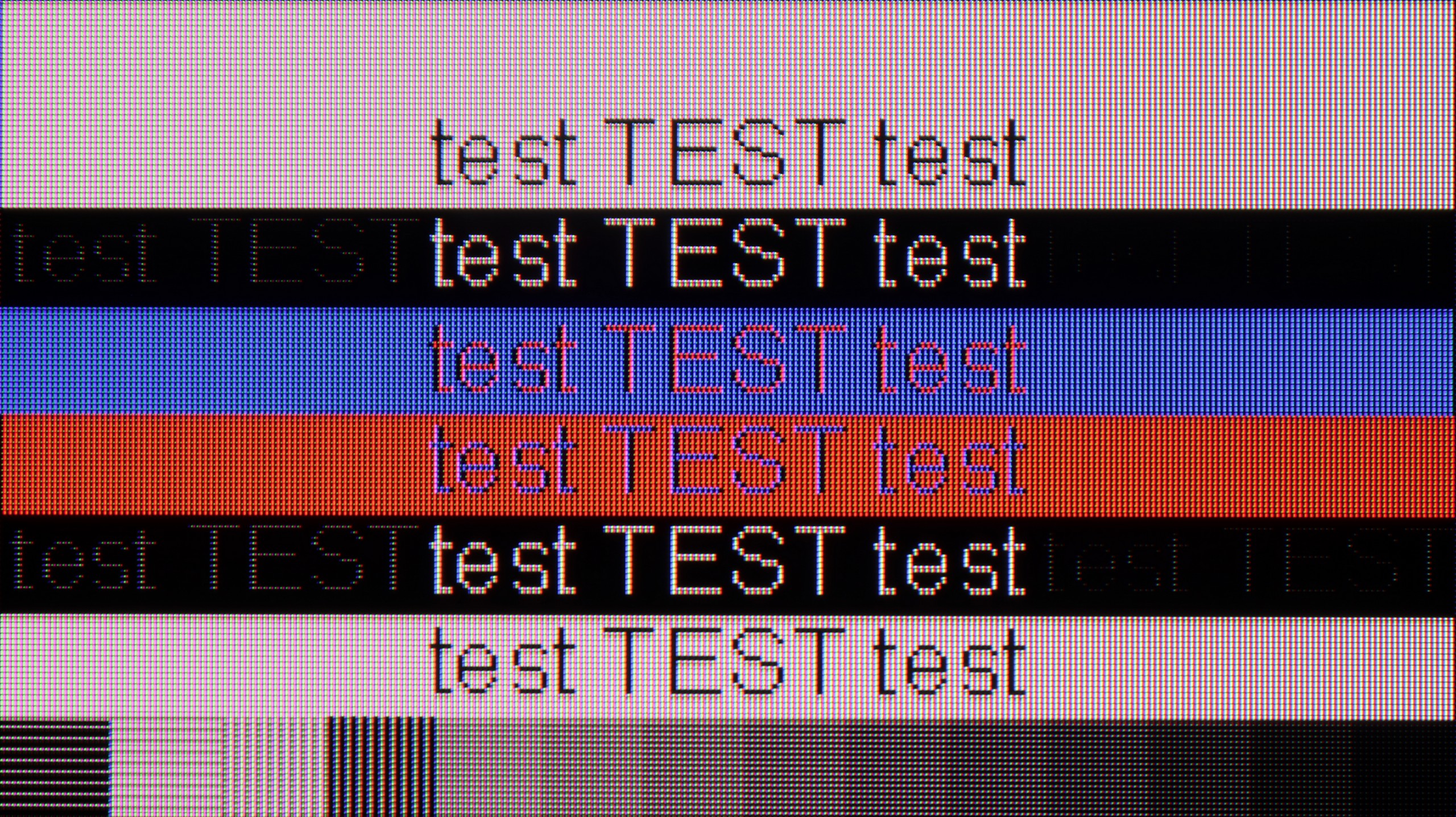

If we plan to connect the C7K to a computer – especially for gaming – there's definitely a lot to play with. We have 4K at 144 Hz, which already sounds great, but if we drop the resolution, the TV can even display 280 Hz. In e-sports, where every split second counts, this really makes a difference. On top of that, it supports G-Sync and FreeSync, so no matter what graphics card we have – the image will be smooth, with no stuttering or tearing.
But if we plan to put the C7K on a desk and use it like a monitor, it's a bit less "rosy." Sure, it supports chroma 4:4:4, so fonts should be sharp, but with very dark letters, you can notice slight blurriness and edge dimming. It's not something that immediately stands out during gaming or watching, but when working with text – it can be distracting. In everyday use – relatively worry-free, but if we plan to have a 50-inch screen a metre from our face, it's worth keeping this in mind.
Cooperation with a PC for the Philips OLED820 varies depending on the usage. It performs exceptionally well for gaming: the high refresh rate of 144 Hz combined with G-Sync support provides a smoothness and responsiveness that other TVs would envy. However, the situation is less favourable for text work. The lack of proper implementation of chroma 4:4:4 means that fonts on coloured backgrounds can appear slightly blurry, which significantly lowers the comfort of working. Therefore, it’s hard to recommend the OLED820 as a screen for office work with text or numbers. It's a pity that the manufacturer couldn’t learn from last year’s models, and this flaw continues to persist.
Viewing angles
3/10
7.6/10
There's no surprise here – the C7K has classic viewing angles for a VA panel. That is: we sit directly in front – it's excellent. Colours look good, contrast is strong, everything is in place. But just shifting slightly to the side starts to make things worse – the image loses saturation, the blacks turn grey, and the overall impression diminishes a bit. So if we plan to watch together with a few people or have a sofa that takes up half the lounge – it’s worth seating everyone more centrally. You can watch from the side, but don’t expect miracles – it’s simply a characteristic of the VA panel.
The viewing angles on the Philips OLED820 are another advantage that should please you. OLEDs have always been characterised by nearly perfect angles, so regardless of where we're looking from, the image remains clear and readable. True, the classic WOLED panel doesn't measure up to technologies like MLA OLED or QD-OLED, but it's still hard to find fault here. The angles are simply excellent.
TV efficiency during daytime
6.1/10
5.7/10
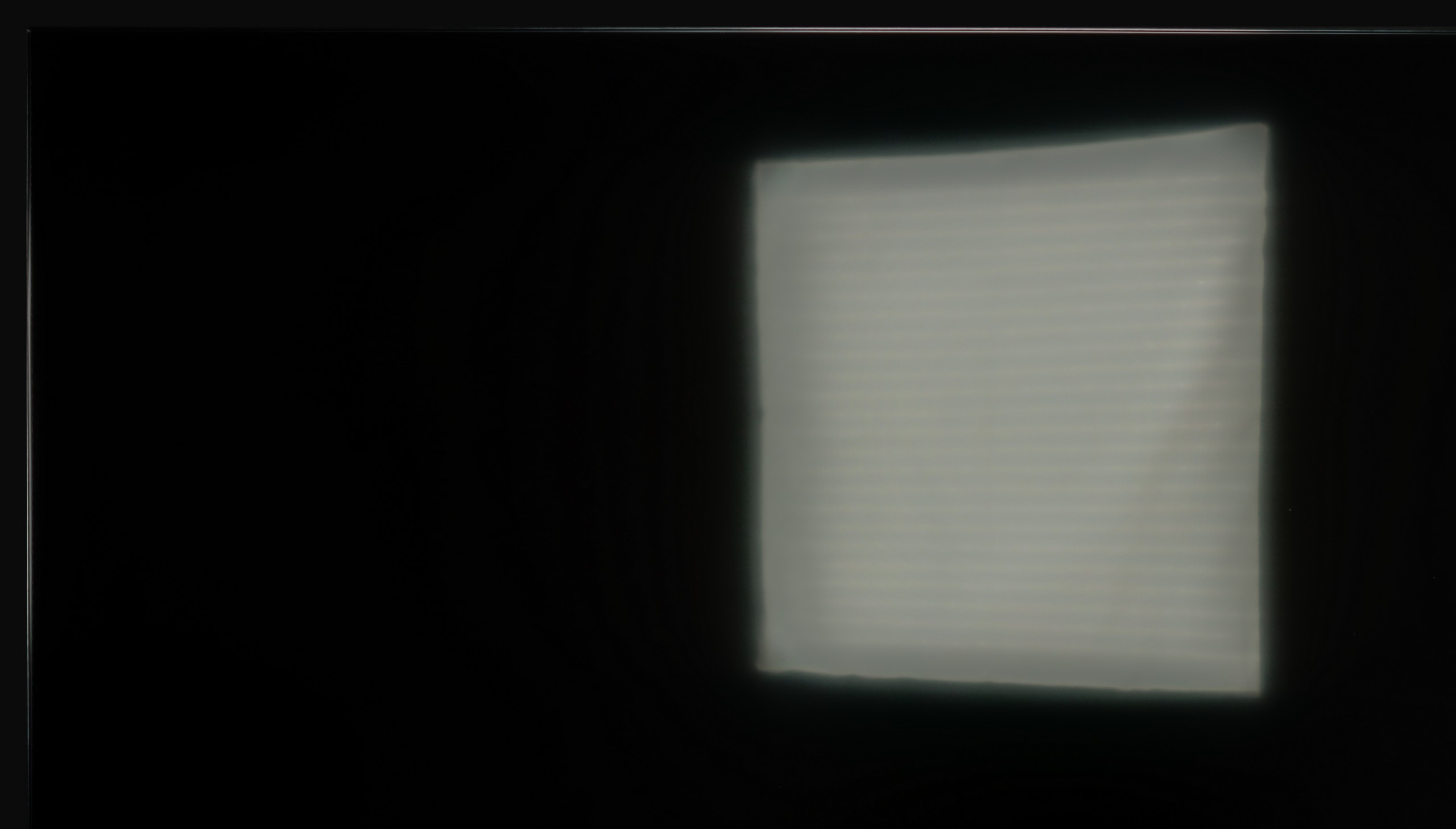



Matrix brightness
Average luminance SDR
Philips OLED820: 345 cd/m2
TCL C7K / QM7K: 475 cd/m2
Luckily, the TCL C7K performs quite well in bright rooms. The applied panel has a satin finish that effectively reduces reflections, so even on sunny days we don't have to worry about reflections from lamps or windows. Importantly, the colours maintain their intensity and don't wash out, as can happen with weaker matte panels. As for brightness, the average for content like YouTube or regular television reaches just below 500 nits. It's not a record result – for example, the MQLED85 (C765) performs better in this regard. However, for everyday viewing during the day, it should work without major issues, as long as we don't plan to place it opposite a south-facing window without curtains.
Details about the matrix
Subpixel Structure:
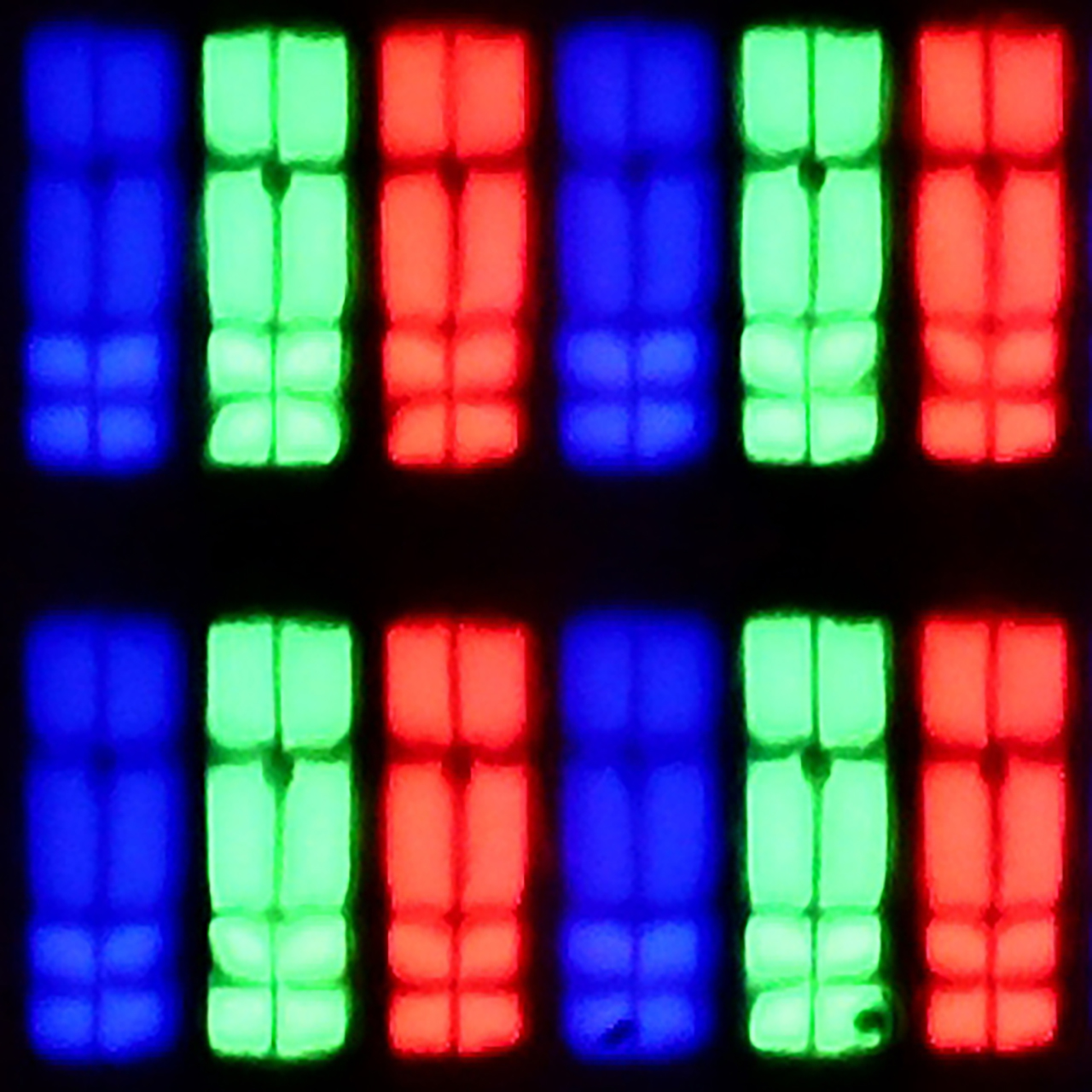
Panel uniformity and thermal imaging:

TV features
7.3/10
6.8/10
- HDMI inputs2 x HDMI 2.0, 2 x HDMI 2.1 48Gbps2 x HDMI 2.0, 2 x HDMI 2.1 48Gbps
- OutputsToslink (Optical audio), eARC (HDMI), ARC (HDMI)Toslink (Optical audio), eARC (HDMI), ARC (HDMI), Mini-Jack (Headphones)
- Network InterfacesWi-Fi 2.4GHz, Wi-Fi 5GHz, Ethernet (LAN) 100MbpsWi-Fi 2.4GHz, Wi-Fi 5GHz, Ethernet (LAN) 100Mbps
- TV receptionDVB-T, DVB-T2, DVB-S, DVB-S2, DVB-CDVB-T, DVB-T2, DVB-S, DVB-S2, DVB-C
Classic features:
- Recording to USB (terrestrial TV)
- Recording programming
- Picture in Picture (PiP)
- RF remote control (no need to aim at the screen)
- Backlit remote control
- Teletext
- Audio only mode
- Bluetooth headphones support
- Simultaneous Bluetooth headphones & TV audio
Smart features:
- AirPlay
- Screen mirroring (Windows Miracast)
- Voice search
- Voice search in native language
- Ability to connect a keyboard and mouse
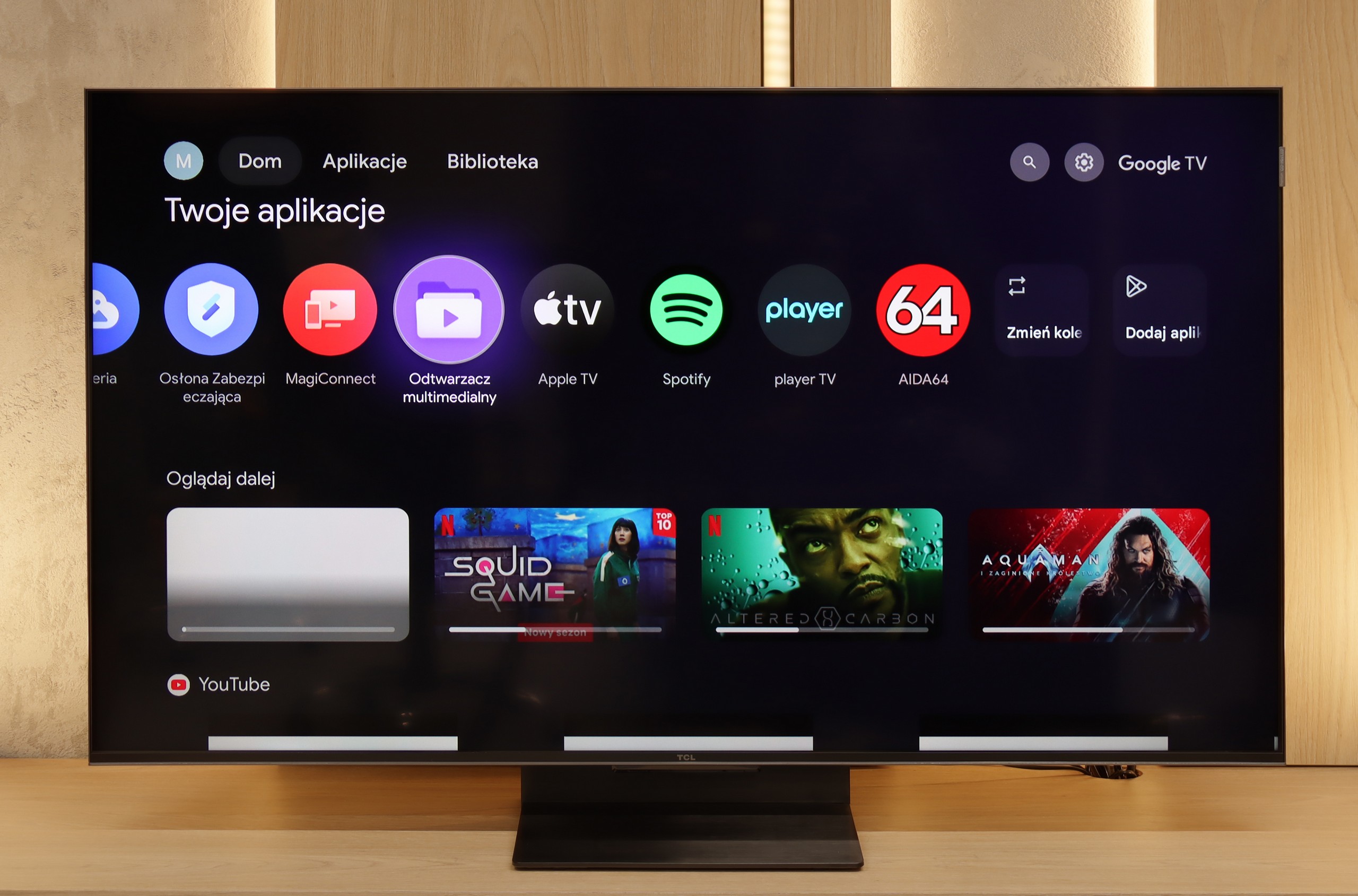
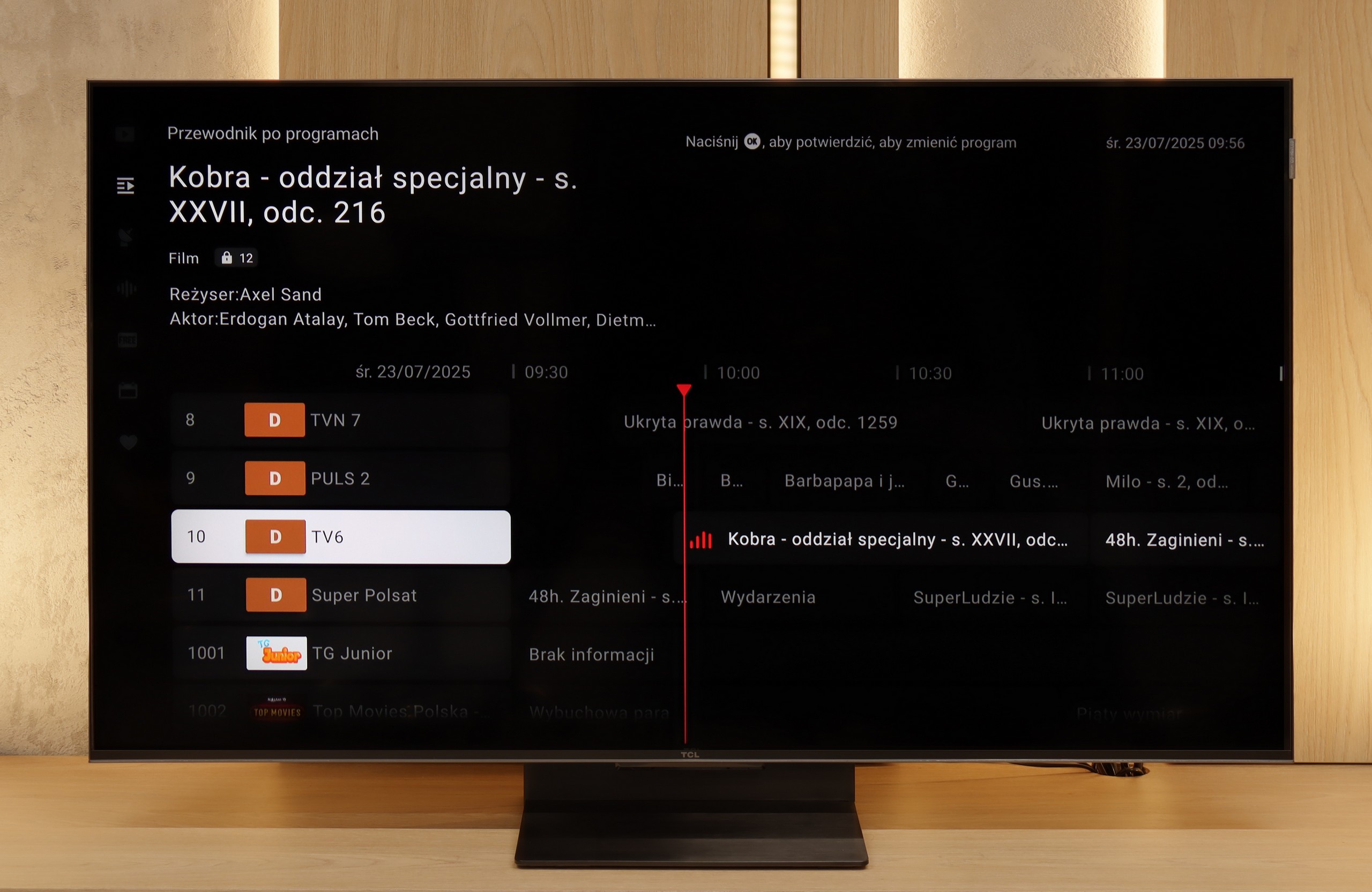
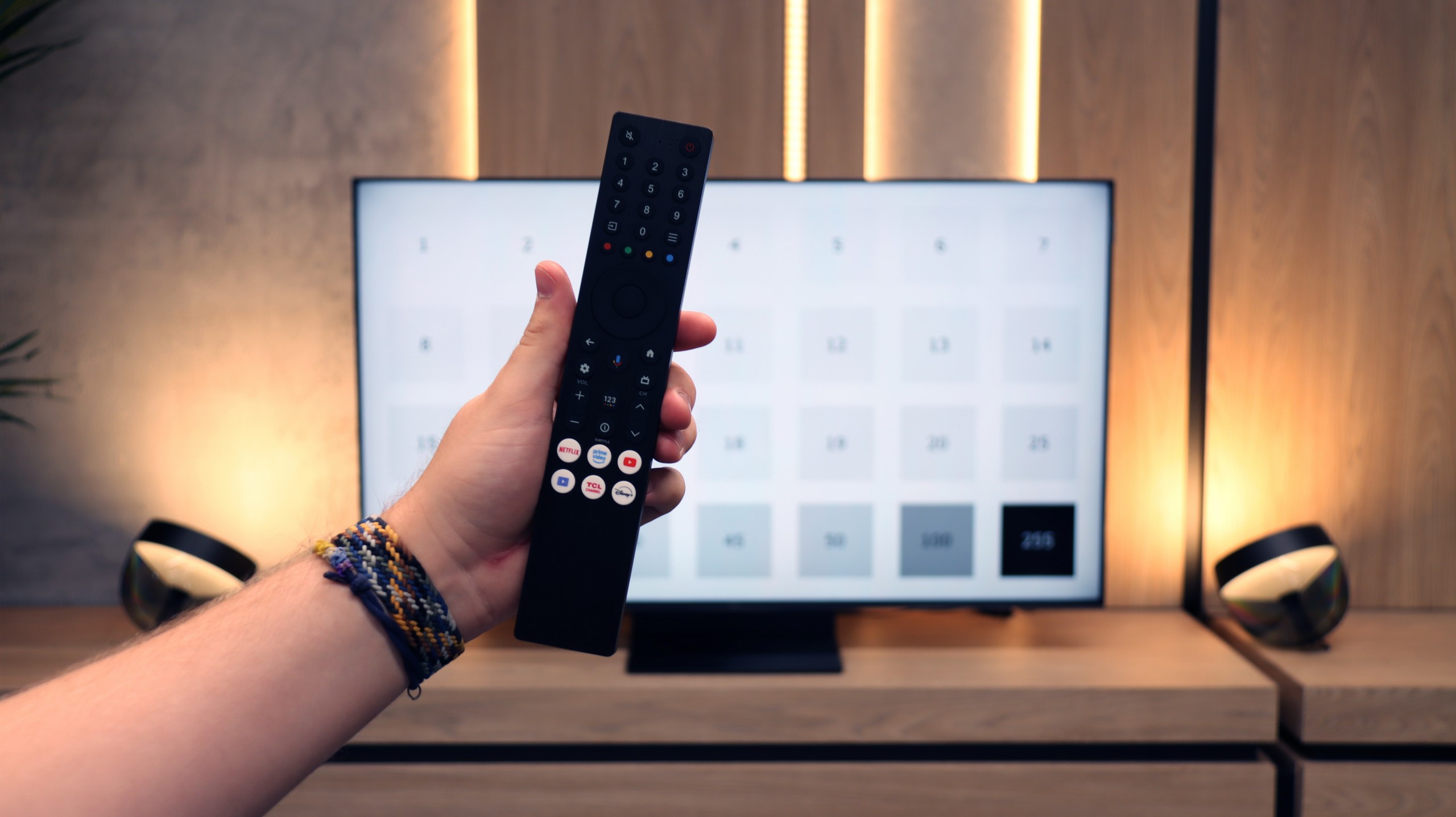
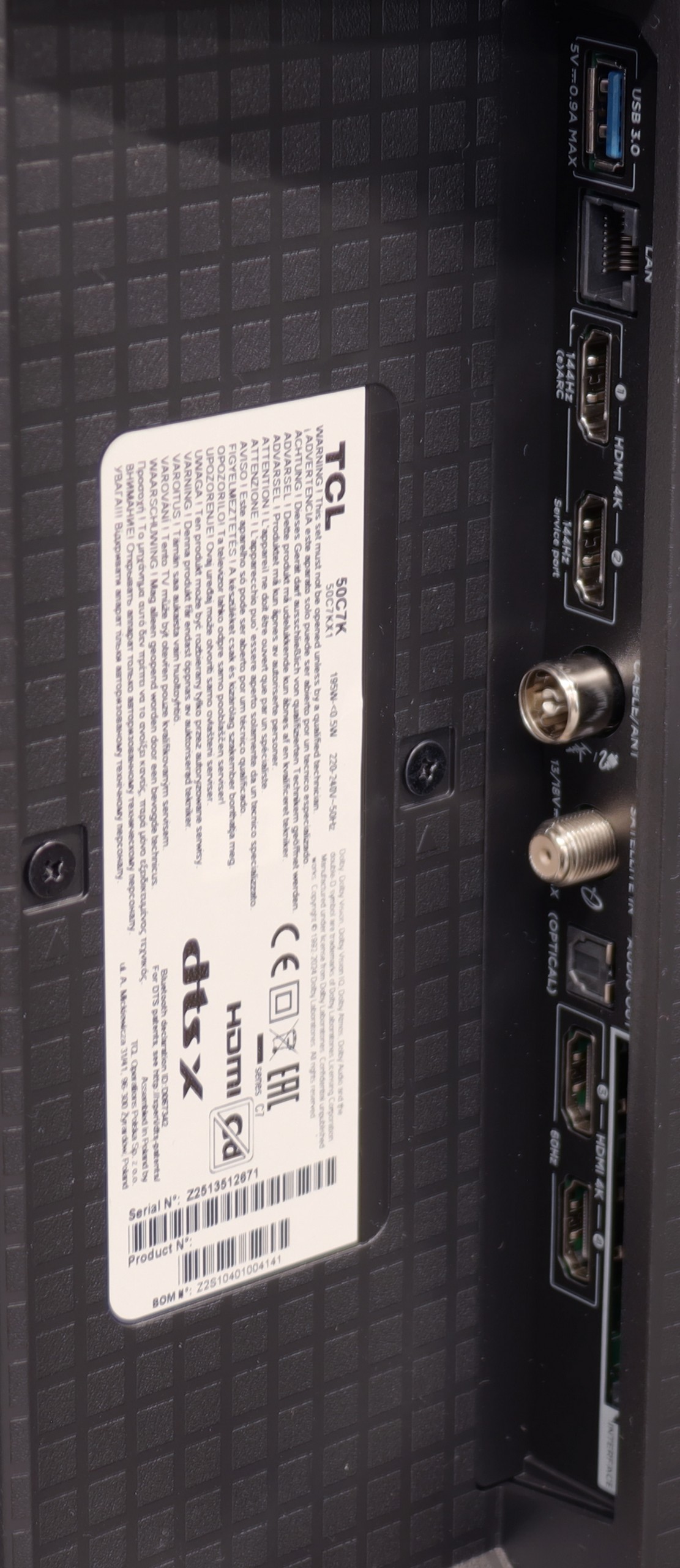




SmartTV: GoogleTV
The biggest strength of the TCL C7K in everyday use is undoubtedly the Google TV system. It is thanks to this that we have access to an almost endless library of applications, including some more niche ones that are often unavailable on other platforms. The built-in Google Assistant understands Polish, so we can easily ask what is on TV, what the weather is like, and even give a few voice commands to control the television. The presence of Chromecast and AirPlay, which work smoothly and make life easier, is also a plus.
Usability Features
However, the traditional functions are a bit lacking. Of course, we have the basics – teletext, EPG, or the ability to connect headphones – but that’s pretty much where it ends. There's a lack of USB recording features or picture-in-picture (PiP) mode, which can still be found among competitors. It's also worth remembering that Google TV in the TCL version sometimes has strangely translated menu sections or minor interface errors. These aren’t issues that hinder daily use, but detail-oriented individuals may notice them.
GoogleTV on OLED820
Philips OLED820 runs on the Google TV system, which immediately places it among televisions that truly provide user freedom. It’s a fantastic platform that doesn’t need any introduction – we find almost an endless number of apps here, from popular VOD services to niche programmes or games. Google TV also allows for personalisation of the home screen, tailoring content to our preferences, so the television actually “learns” our viewing style. A huge plus is also the Google voice assistant – fast, natural, and effective. It can understand even less obvious questions, and in practice, it works significantly better than many competitors. Unfortunately, there was a hiccup – the screen mirroring function simply didn’t work during testing. This can be seen as a minor issue, but in 2025, such things simply shouldn’t happen.
Classic Features of OLED820
When it comes to classic features, the OLED820 doesn’t attempt to play conservatively. On one hand, we get a backlit remote control with a numeric keypad, which is quite well organised and comfortable to use. On the other hand, you have to aim it at the screen, as it works on infrared, which is more reminiscent of equipment from a decade ago than a modern television. It also lacks a few features that are often found in competitors – there’s no USB recording from tuners or a PiP mode. A nice touch among the classic solutions is the mini jack analogue input for headphones. This is rare nowadays and can be quite useful – whether for a senior citizen with an additional headphone station or for someone wanting to connect older speakers.
AmbilightTV OLED820
You can’t overlook Ambilight, which is a hallmark of Philips. This solution impacts not only the appearance of the television but also the reception of content. The lighting system can be set in various ways, from a multi-coloured mode dynamically tracking the image to calmer, static lighting. We definitely recommend the latter option, as the gentle light behind the screen makes the content viewed, in combination with the OLED matrix, appear even deeper and more engaging. It’s a simple yet very striking addition that has characterised Philips televisions for years.
Playing files from USB
9.2/10
9.5/10
Supported photo formats:
Maximum photo resolution:
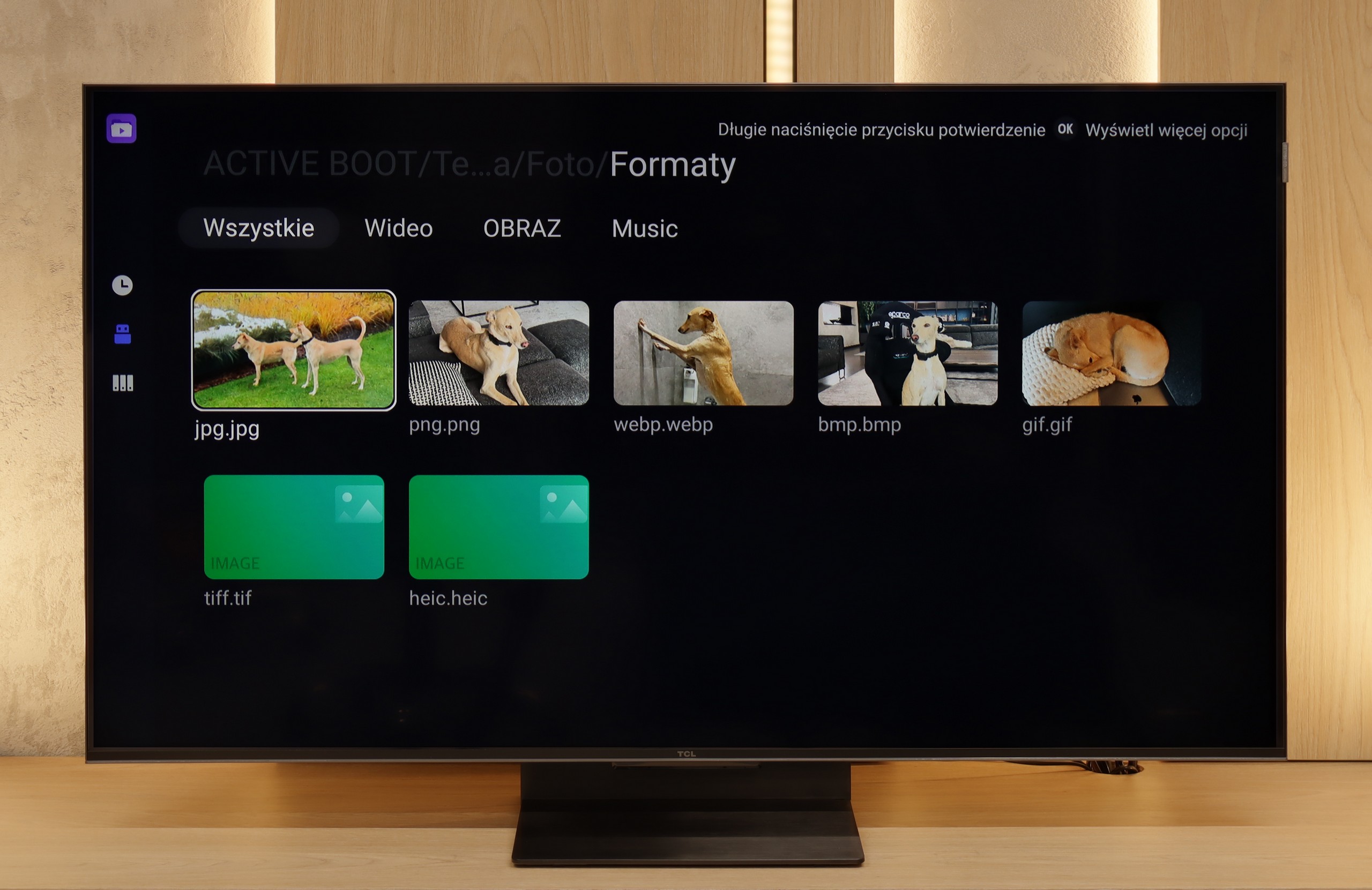

The built-in file player in the TCL C7K performs really well. It supports most popular audio and video formats, so if we want to quickly plug in something from a USB drive and get it going – there shouldn't be any problem. Of course, as is often the case, you can find some minor shortcomings – not every exotic codec will work (Apple's HEIC), not all subtitles will be perfectly synchronised (txt.). However, the biggest advantage of this television comes to the rescue, which is Google TV. With access to the Google Play Store, we can easily install an alternative player, such as VLC, and then no files will frighten us.
The Philips OLED820 has a built-in file player with USB, which at first glance looks quite clunky, but in practice works surprisingly well. You could even say it's one of the best built-in players available in televisions. It handles virtually every type of file: photos, videos, or music, with minor exceptions that most of the competition also does not support. And if someone still finds something missing, there's always the option to install the VLC app from the Google Play library and the problem disappears.
Apps
9.6/10
9.6/10














































Sound
7/10
7.7/10
- Maximum volume76dB81dB
- Dolby Digital Plus 7.1
- Dolby True HD 7.1
- Dolby Atmos in Dolby Digital Plus (JOC)
- Dolby Atmos in Dolby True HD
- DTS:X in DTS-HD MA
- DTS-HD Master Audio
To be honest, we didn't expect much from the sound of the 50-inch version of the C7K model. Usually, in such sizes, it's hard to find anything more than thin, flat sound. But here – a pleasant surprise. The sound turned out to be really enjoyable, with good clarity and even a subtly noticeable bass. This is probably linked to TCL's new collaboration with the Bang & Olufsen brand, which is a novelty for 2025. Whether the C7K actually contains original drivers from the Danish premium brand – we can't confirm that. But the end result still deserves a thumbs up. For a TV without a soundbar – it sounds quite nice.
Philips OLED 820 features a built-in 4.1 speaker system with a total output of 70 W. At the back of the casing, there’s a subwoofer that delivers quite solid and deep bass. The classic speakers responsible for the remaining sound range are located at the bottom of the television, which means that the audio doesn't always distribute as we would like. However, the overall sound quality can be considered satisfactory – series, TV shows, or the occasional music listening all perform well with a slight bass enhancement. For everyday use, this should be sufficient, although we still recommend purchasing even an inexpensive soundbar, which will significantly improve the user experience.
Acoustic Measurements
76dBC (Max)
75dBC
81dBC (Max)
75dBC


